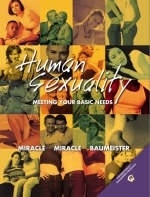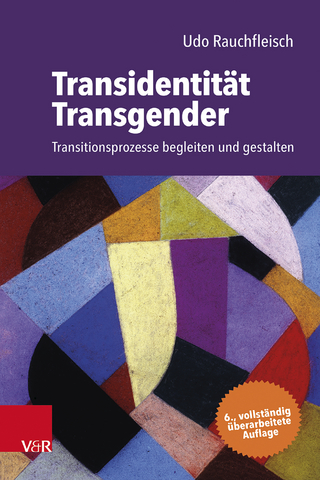
Human Sexuality
Pearson (Verlag)
978-0-13-032658-4 (ISBN)
- Titel ist leider vergriffen;
keine Neuauflage - Artikel merken
For courses in Human Sexuality found in departments of psychology, health, biology, nursing, physical education, sociology, and anthropology.
This text provides an accessible, comprehensive introduction to human sexuality as it relates to basic human needs in five different categories: Physical Needs, Social Needs, Emotional Needs, Spiritual Needs, and Cognitive Needs. Major concepts discussed are neither over simplified, nor overly technical—allowing instructors the flexibility to stimulate student curiosity and imagination. In addition, a variety of visually appealing, pedagogical aids reinforce the major points of the text.
TINA AND ANDY MIRACLE. Had we read the research in Chapter 15 before we got married more than three decades ago, this book might not have been written. We got engaged after two dates, and did not have proximity, familiarity, or similarity going for us; luckily, there was plenty of readiness and reciprocity. Proximity was a definite problem since Andy spent most of our year-long engagement period living in Tarija, Bolivia doing community development work, while Tina was going to school and working in New York. Two dates is hardly adequate time for much familiarity, and dissimilarities abounded given our different religious and cultural backgrounds. However, over the years we have each learned to compromise and to trust one another. The result is that as individuals we both feel that the costs of occasional inconveniences are greatly outweighed by the continuing benefits of the relationship (see social exchange theory in Chapter 1). In non-scientific terms, after more than 30 years of marriage we still love each other and while sometimes we're not sure we want to spend the next hour together, we know we want to spend the rest of our lives together. Over the years, we have heard every possible comment on our last name, and also managed successfully to merge our personal and professional lives. Tina began her undergraduate degree in English at Chatham College, and completed her B.A. as well as her master's and a specialist's degree (Ed.S.) in counseling at the University of Florida. An undergraduate religion major at Princeton University, Andy received a master's degree in Latin American Studies and his Ph.D. in Anthropology at the University of Florida. With then three-year-old daughter Rebekah and newborn son Jed, we spent a year in La Paz, Bolivia while Andy completed his dissertation research among the Bolivian Aymara with the assistance of a Fulbright-Hays award and a grant from the National Institute of Mental Health. As a cultural anthropologist, Andy not only enjoys teaching but he has published extensively, including ten books in the fields of anthropology and education, sports sociology, culture and health, and human sexuality. He began his academic career at Texas Christian University in 1976, was chair of the Department of Health Sciences at Cleveland State University for four years, and currently is Associate dean of the College of Health and Urban Affairs and Professor of Public Health at Florida International University. Andy is past president of both the Southern Anthropological Society and The Association for the Study of Play. For the first twenty years of Tina's career as a psychotherapist, she worked primarily with survivors of sexual abuse and assault as clinical director at a residential treatment center for emotionally disturbed children, in private practice, and at a rape crisis center. She is a licensed professional clinical counselor and a member of the American Association of Sex Educators, Counselors and Therapists. When a retinal disease resulted in Tina becoming severely visually impaired, she began working with blind and visually impaired children and their families at the Cleveland Sight Center, and currently she is a research and clinic coordinator at the Bascom Palmer Eye Institute at the University of Miami School of Medicine. Together, Tina and Andy frequently give lectures and workshops on issues related to human sexuality. ROY F. BAUMEISTER. You might think that no one would have to explain how he or she became interested in sex. After all, everyone is interested in sex, right? And yet relatively few people in my field of social psychology actually study sex. When I finished high school, I chose to attend Princeton because it was reputed to have the best mathematics department in the country, and I intended to become a mathematician. A couple semesters of higher mathematics soon persuaded me, however, that I wanted something with more intrinsic interest and more relevance to the central aspects of human life. My next choice was philosophy, because I thought it would enable me to grapple with the grand, ultimate questions about the human condition. Unfortunately, most philosophers these days have to choose narrow rather than grand questions, and moreover there are not many jobs for them. While reading moral philosophy, I came across some of Freud's writings and was struck by one astonishing fact: He was trying to decide which ideas were right by using scientific observations. I began to realize that psychologists could tackle great questions and they even had the scientific method to help them find the right answers. In graduate school at Duke and again at Princeton, I learned how to conduct laboratory experiments. Issues of self and identity were first gaining recognition as important keys to life, and so my early work explored issues of self-esteem, public constraints on identity, and what happens when people focus attention on themselves. Although I continue to find such work satisfying, I became chagrined at the narrow focus that one had to keep. A crucial step in my career occurred when I found that one could tackle broad questions by pulling together the results of many different studies. A single experiment had to focus on something narrow, but by combining many different findings one could begin to see the big picture. To me, this was the key for how to go back to addressing the broad philosophical questions that fascinated me. Some of my book titles reflect these efforts: Meanings of Life, Evil.-Inside Human Violence and Cruelty, Identity: Cultural Change and the Struggle for Self. To me, sex is another one of the grand mysteries of life, and so it was a natural topic to pick up when I had finished my work on evil and violence and was looking for something new and interesting. For the book on evil, I had had to immerse myself in reading about a great many terrible things that people have done to one another, and the idea of moving on to study sex was appealing because it promised a chance to focus on a more pleasant, positive aspect of human nature. Roy F. Baumeister received his Ph.D. in social psychology from Princeton University and had a postdoctoral fellowship in sociology at the University of California at Berkeley. In 1979 he joined the faculty of Case Western Reserve University as an assistant professor and rose through the ranks, becoming at one point the youngest full professor at the university. He now holds the E. B. Smith Professorship in the Liberal Arts there. He has also taught and done research at the University of Virginia, the University of Texas, the Max-Planck-Institute in Munich, Germany, and at the Center for Advanced Study in the Behavioral Sciences at Stanford University. He has published nearly 250 scientific works including 14 books.
(NOTE: Each chapter concludes with a Chapter Review and Suggested Readings.)
1. Finding Your Way in a Diverse World.
Human Sexuality and Basic Needs. Meeting Your Needs. Sexuality and Human Diversity. Sex Research. Theoretical Perspectives on Sexuality. Ask Yourself.
2. Human Sexual Anatomy and Physiology.
A. Female Sexual Anatomy and Physiology. Female Internal Sexual Organs. Female External Sexual Organs. The Menstrual Cycle. Menopause. Disorders of the Female Sex Organs. Breasts. Diseases of the Breast. B. Male Sexual Anatomy and Physiology. Male Internal Sexual Organs. Male External Sexual Organs. Disorders of the Male Sexual Organs.
3. Sexual Arousal and Response.
One Advantage of Being Homo Sapiens. Biological Foundations for Sexual Arousal and Response. Sex Hormones. The Sexual Response Cycle. Orgasm. Sexuality and Disabilities.
4. Sexual Dysfunctions and Therapies.
Disorders of Sexual Desire. Disorders of Sexual Arousal. Orgasmic Disorders. Sexual Pain Disorders. Effects of Drugs and Alcohol on Sexual Function. Sexual Therapy.
5. Conception, Pregnancy, and Birth.
Conception. Fetal Development. Pregnancy Detection. Pregnancy. The Responsibilities of Pregnancy. Problems in Pregnancy. Expectant Fathers. The Birth Experience. Postpartum. Infertility.
6. Contraception and Abortion.
A Brief History of Contraception and Abortion. An Overview of Birth Control Today. Barrier Methods of Birth Control. Mechanical Methods of Birth Control. Chemical Methods of Birth Control. Hormone-Based Contraceptives. Surgical Methods of Birth Control. Fertility Awareness Methods. Postcoital Contraception. Abortion. New and Future Contraceptive Technology.
7. Sexually Transmitted Infections.
What Are Sexually Transmitted Infections (STIs)? Bacterial Infections. Viral Infections. Parasitic Infections. Ways to Avoid STIs. What to Do if You Get an STI.
8. Social Control of Sexuality.
Who? Social Control and the Selection of a Sexual Partner. When? Social Control of the Timing of Sexual Relations. Where? How Society Influences the Location of Sexual Activity. How? Social Regulation of Sexual Behavior. Why? Reasons for Social Control of Sexuality. The Double Standard and Suppression of Female Sexuality.
9. Sex Across the Life Span.
Birth and Childhood. Adolescence: The Transition to Adulthood. Adulthood: The Transition to Maturity. Aging: The Final Transition.
10. Sex and Gender.
Males, Females, and Intersexuals. Sexual Differentiation. Gender Roles. Gender Identity. Gender Identity Disorders.
11. Sexual Orientation.
A Continuum of Sexual Orientation. The Basis of Sexual Orientation. Dating, Sex, and Relationships. Homophobia. Coming Out of the Closet.
12. Consensual Sexual Behavior.
Celibacy. Sexual Arousal During Sleep. Autoerotic Sexual Activity. Sex with a Partner. Atypical Sexual Behaviors.
13. Sexual Coercion.
Nonconsenting Sexual Behaviors. Verbal Sexual Coercion. Forcible Sex.
14. The Business of Sex.
Why Sex Sells. Prostitution. Pornography. Sex and Profits.
15. Sex and Love.
What Is Love? Attraction: Looking for Love. Romance: Falling in Love. Sex: Making Love. Attachment: Staying in Love. Intimacy, Love, and Sexual Communication.
16. Sex and Heartache.
Relationships Can Make You Sad. Relationships Can Make You Mad. Relationships Can Make You Scared.
17. Sexuality, Spirituality, and Religious Traditions.
Spirituality and Sexuality. Sexuality and Religion. Sexuality and Religious Traditions.
18. Sexual Politics and Legal Issues.
Sexual Politics. The Politics of Sex Research. Gay and Lesbian Rights. The Politics of AIDS. Reproductive Rights. Ask Yourself. Regulating the Sexual Behavior of Consenting Adults. Some Unintended Effects of Legislation.
19. Sexuality Education.
Who Decides What Gets Taught? Where Should Sexuality Education Be Taught? What Should Sexuality Education Courses Teach? Does Sexuality Education Make a Difference? Do Parents Talk About Sexuality? Do Their Children Listen?
20. Defining Responsibility in a Changing World.
Values and Sexuality. Sexual Ethics. Sexual Decision-Making. Ask Yourself.
| Erscheint lt. Verlag | 17.6.2002 |
|---|---|
| Sprache | englisch |
| Maße | 223 x 283 mm |
| Gewicht | 1663 g |
| Themenwelt | Geisteswissenschaften ► Psychologie ► Sexualität / Partnerschaft |
| ISBN-10 | 0-13-032658-5 / 0130326585 |
| ISBN-13 | 978-0-13-032658-4 / 9780130326584 |
| Zustand | Neuware |
| Haben Sie eine Frage zum Produkt? |
aus dem Bereich


